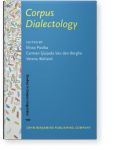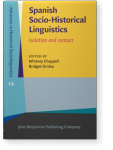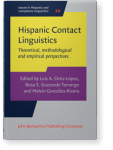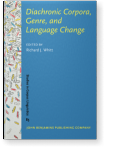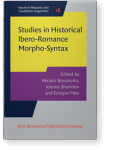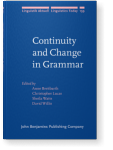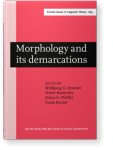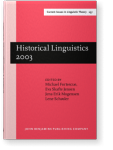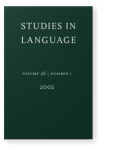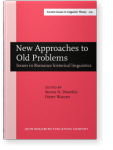Andrés Enrique-Arias
List of John Benjamins publications for which Andrés Enrique-Arias plays a role.
2023 Testing Twitter data on a morphosyntactic variable: The expression of the future in American and Peninsular Spanish Corpus Dialectology, Pustka, Elissa, Carmen Quijada Van den Berghe and Verena Weiland (eds.), pp. 176–196 | Chapter
This research investigates the distribution of the morphological future cantaré (MF) and periphrastic future voy a cantar (PF) in Latin American Spanish compared to Peninsular Spanish through an analysis of Twitter data collected in six Spanish-speaking cities. Due to the written nature of the… read more
2021 Vamos en Palma ‘we are going to Palma’: On the persistence (and demise) of a contact feature in the Spanish of Majorca Spanish Socio-Historical Linguistics: Isolation and contact, Chappell, Whitney and Bridget Drinka (eds.), pp. 185–204 | Chapter
This study analyzes historical and contemporary data of Spanish produced by Catalan-dominant bilinguals in Majorca to explore the origin and historical evolution of a contact feature of Majorcan Spanish: the preposition en to express direction of movement. The transgenerational survival of this… read more
2020 Chapter 13. On the effects of Catalan contact in the variable expression of Spanish future tense: A contrastive study of Alcalá de Henares, Madrid and Palma, Majorca Hispanic Contact Linguistics: Theoretical, methodological and empirical perspectives, Ortiz López, Luis A., Rosa E. Guzzardo Tamargo and Melvin González-Rivera (eds.), pp. 315–334 | Chapter
This paper aims to test the influence of Catalan-Spanish bilingualism in the variable distribution of the morphological future (MF) cantaré and the periphrastic variant (PF) voy a cantar in Spanish. As Catalan does not have a PF, it has been suggested that in the areas where Spanish coexists with… read more
2018 Some methodological issues in the corpus-based study of morphosyntactic variation: The case of Old Spanish possessives Diachronic Corpora, Genre, and Language Change, Whitt, Richard J. (ed.), pp. 261–280 | Chapter
This paper has two main objectives: to point out some of the challenges surrounding the study of morphosyntactic variation and change through historical corpora, and to present some methodological alternatives to help alleviate these problems using the specific case study of the expression of… read more
2018 Chapter 11. Si as a Q-particle in Old Spanish Studies in Historical Ibero-Romance Morpho-Syntax, Bouzouita, Miriam, Ioanna Sitaridou and Enrique Pato (eds.), pp. 249–274 | Chapter
This study examines the origin of Old Spanish direct interrogative si, a structure that has barely been described in the literature. An analysis of historical texts shows that it originates from the Classical Latin conditional conjunction si, which in Late Latin became a complementiser in embedded… read more
2010 On language contact as an inhibitor of language change: The Spanish of Catalan bilinguals in Majorca Continuity and Change in Grammar, Breitbarth, Anne, Christopher Lucas, Sheila Watts and David Willis (eds.), pp. 97–118 | Article
This study explores the role of language contact as an inhibitor of language change through the historical analysis of several features that are characteristic of the Spanish in contact with Catalan in the island of Majorca. The analysis reveals that (i) these features are attested in Majorcan… read more
2005 When Clitics Become Affixes, Where do they Come to Rest? A Case from Spanish Morphology and its demarcations: Selected papers from the 11th Morphology meeting, Vienna, February 2004, Dressler, Wolfgang U., Dieter Kastovsky, Oskar E. Pfeiffer and Franz Rainer (eds.), pp. 67–79 | Article
2005 Using Universal Principles of Phonetic Qualitative Reduction in Grammaticalization to explain the Old Spanish Shift from ge to se Historical Linguistics 2003: Selected papers from the 16th International Conference on Historical Linguistics, Copenhagen, 11–15 August 2003, Fortescue, Michael, Eva Skafte Jensen, Jens Erik Mogensen and Lene Schøsler (eds.), pp. 103–114 | Article
2002 Accounting for the position of verbal agreement morphology with psycholinguistic and diachronic explanatory factors Studies in Language 26:1, pp. 1–31 | Article
This article attempts a more complete explanation of the position of verbal agreement affixes which, unlike other inflections, lack a correlation with word order and are prefixes relatively more frequently. An analysis of the factors that determine the position of affixes during morphologization… read more
2000 Spanish Object Agreement Markers and the Typology of Object Agreement Morphology New Approaches to Old Problems: Issues in Romance historical linguistics, Dworkin, Steven N. and Dieter Wanner (eds.), pp. 149–164 | Chapter
